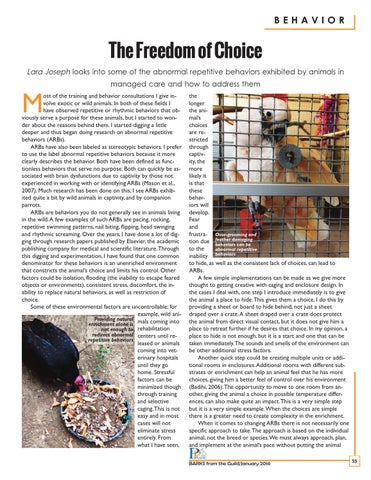The Freedom of Choice
BEHAVIOR
Lara Joseph looks into some of the abnormal repetitive behaviors exhibited by animals in
M
managed care and how to address them
ost of the training and behavior consultations I give involve exotic or wild animals. In both of these fields I have observed repetitive or rhythmic behaviors that obviously serve a purpose for these animals, but I started to wonder about the reasons behind them. I started digging a little deeper and thus began doing research on abnormal repetitive behaviors (ARBs). ARBs have also been labeled as stereotypic behaviors. I prefer to use the label abnormal repetitive behaviors because it more clearly describes the behavior. Both have been defined as functionless behaviors that serve no purpose. Both can quickly be associated with brain dysfunctions due to captivity by those not experienced in working with or identifying ARBs (Mason et al., 2007). Much research has been done on this; I see ARBs exhibited quite a bit by wild animals in captivity, and by companion parrots. ARBs are behaviors you do not generally see in animals living in the wild. A few examples of such ARBs are pacing, rocking, repetitive swimming patterns, nail biting, flipping, head swinging and rhythmic screaming. Over the years, I have done a lot of digging through research papers published by Elsevier, the academic publishing company for medical and scientific literature. Through this digging and experimentation, I have found that one common denominator for these behaviors is an unenriched environment that constricts the animal’s choice and limits his control. Other factors could be isolation, flooding (the inability to escape feared objects or environments), consistent stress, discomfort, the inability to replace natural behaviors, as well as restriction of choice. Some of these environmental factors are uncontrollable; for example, wild aniProviding natural mals coming into enrichment alone is not enough to rehabilitation redirect abnormal centers until rerepetitive behaviors leased or animals coming into veterinary hospitals until they go home. Stressful factors can be minimized though through training and selective caging. This is not easy and in most cases will not eliminate stress entirely. From what I have seen,
the longer the animal’s choices are restricted through captivity, the more likely it is that these behaviors will develop. Fear and frustra- Over-grooming and damaging tion due feather behaviors can be to the abnormal repetitive inability behaviors to hide, as well as the consistent lack of choices, can lead to ARBs. A few simple implementations can be made as we give more thought to getting creative with caging and enclosure design. In the cases I deal with, one step I introduce immediately is to give the animal a place to hide. This gives them a choice. I do this by providing a sheet or board to hide behind, not just a sheet draped over a crate. A sheet draped over a crate does protect the animal from direct visual contact, but it does not give him a place to retreat further if he desires that choice. In my opinion, a place to hide is not enough, but it is a start and one that can be taken immediately. The sounds and smells of the environment can be other additional stress factors. Another quick step could be creating multiple units or additional rooms in enclosures. Additional rooms with different substrates or enrichment can help an animal feel that he has more choices, giving him a better feel of control over his environment (Badihi, 2006). The opportunity to move to one room from another, giving the animal a choice in possible temperature differences, can also make quite an impact. This is a very simple step but it is a very simple example. When the choices are simple there is a greater need to create complexity in the enrichment. When it comes to changing ARBs there is not necessarily one specific approach to take. The approach is based on the individual animal, not the breed or species. We must always approach, plan, and implement at the animal’s pace without putting the animal BARKS from the Guild/January 2016
55
